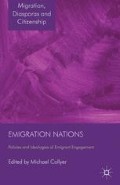Abstract
Ethiopia is one of the largest and poorest countries in sub-Saharan Africa. Although Ethiopia has a low emigration rate at 0.7 per cent (World Bank, 2011), compared to other sub-Saharan African countries, due to its sheer population size of approximately 83 million people, it has a large diaspora community in absolute terms. The exact size of the diaspora is unknown, but is estimated to be 1–2 million people with large populations in the Middle East, North America and Europe. Ethiopians are the second largest group of sub-Saharan Africans in the United States (after Nigeria) and the fifteenth largest in Europe (AFTDC-AFTQK, 2007).
Access this chapter
Tax calculation will be finalised at checkout
Purchases are for personal use only
Preview
Unable to display preview. Download preview PDF.
References
AFTDC-AFTQK (2007) ‘Concept note: Mobilizing the African diaspora for development’ Capacity Development Action Plan Unit (AFTDC) and Operational Quality and Knowledge Service Department (AFTQK). African Diaspora Program, World Bank. Available at http://web.worldbank.org/WBSITE/EXTERNAL/COUNTRIES/AFRICAEXT/EXTDIASPORA/0„menuPK:4246156~pagePK: 64168427~piPK:64168435~theSitePK:4246098,00.html. Accessed 8 August 2010.
Anbesse, B., Hanlon, C., Alem, A., Packer, S. and Whitley, R. (2009) ‘Migration and mental health: A study of low-income Ethiopian women working in Middle Eastern countries’, International Journal of Social Psychiatry 55(6), 557–568.
Baldwin-Edwards, M. (2005) ‘Migration in the Middle East and Mediterranean’, paper prepared for the Policy Analysis and Research Programme of the Global Commission on International Migration. Available at www.gcim.org/attachements/RS5.pdf. Accessed on 27 June 2010.
Bariagaber, A. (1997) ‘Political violence and the uprooted in the Horn of Africa: A study of refugee flows from Ethiopia’, Journal of Black Studies 28(1), 26–42.
Belai, B.H. (2007) Enabling Diaspora Engagement in Africa: Resources, Mechanisms and Gaps: Case Study Ethiopia (Ottawa: The Association for Higher Education and Development (AHEAD)).
Berhanu, B. and White, M. (2000) ‘War, famine, and female migration in Ethiopia, 1960–1989’, Economic Development and Cultural Change 49(1), 91–113.
Chacko, E. and Gebre, P. (2009) ‘Diaspora investments, motivations, and challenges: The case of Ethiopia’, World Bank International Conference on Diaspora and Development, 13–14 July, Washington, DC.
Embassy of Ethiopia in the United Kingdom (2009) Features of the Millennium Development Bond. Available at http://www.ethioembassy.org.uk/Millenium%20Bond/Ethiopian%20Millenium%20Bond.htm. Accessed 14 November 2009.
Embassy of Ethiopia in the United States (2009) ‘Duty-free importation’. Available at http://www.ethiopianembassy.org/services/Duty%20free.shtml. Accessed 15 June 2010.
Embassy of Ethiopia Washington (2010) ‘Authority Lifts Duty Free Incentive’. Available at: http://www.ethiopianembassy.org/ConsularServices/ConsularService.php?Page=DutyFreeNotes.htm&left=2. Accessed 18 June 2010.
Gamlen, A. (2006) ‘Diaspora engagement policies: What are they, and what kinds of states use them?’ Working Paper No. 32 (Oxford: Centre on Migration Policy and Society).
Hussen, T. (2010) ‘Ethiopia’s experience on migration’, unpublished report, Addis Ababa: Ethiopian Expatriate Affairs, Government of Ethiopia.
ICMPD and IOM (2010a) Proceedings from Dialogue on Mediterranean Transit Migration (MTM) Final Conference, Addis Ababa, Ethiopia, 12–14 April.
ICMPD and IOM (2010b) ‘Mediterranean Transit Migration (MTM): A dialogue in action’, Linking Emigrant Communities for more Development, Inventoty of Institutional Capacities and Practices (Vienna: ICMPD).
Kebebe, E. (2002) ‘Ethiopia: An assessment of the international labour migration situation: The case of female labour migrants’, GENPROM Working Paper No. 3, Series on Women and Migration. Available at http://www.ilo.org/employment/Whatwedo/Publications/lang--en/docName--WCMS_117931/index.htm. Accessed 8 August 2010.
Ketkar, S. and D. Ratha (2009) ‘New paths to funding: When financing is scarce, developing countries may try innovative approaches to raise capital’, Finance and Development, June 46(2).
Lyons, T. (2007) ‘Conflict-generated diaspora and transnational politics in Ethiopia’, Conflict, Security & Development 7(4), 529–549.
Mekuria, I. (2006) ‘Duty free amendment offers reprieve until October’, Addis Fortune. Available at http://allafrica.com/stories/200608150483.html. Accessed 8 August 2010.
Migration for Development (2010) ‘Socio-economic reintegration for illegally trafficked Ethiopian women and returnees from the Middle East’. Available at http://www.migration4development.org/content/socio-economic-reintegration-illegally-trafficked-ethiopian-women-and-returnees-middle-east. Accessed 8 August 2010.
Ministry of Foreign Affairs Representative, personal communication, 18 April 2010.
National Bank of Ethiopia (NBE) (2009) ‘Remittance Service’. Availalbe at: http://www.nbe.gov.et/remittanceservice/index.html. Accessed 18 June 2010.
Negash, M. (2009) Ethiopian Diaspora Investment Potential and EEPCO’s Millennium Bond (Witwatersrand: University of Witwatersrand).
Organization for Economic Cooperation and Development (OECD) (2005) Migration Statistics: Ethiopia. Available at http://www.oecd.org/infobycountry. Accessed 14 November 2009.
Ratha, D. and Ketkar, S. (2007) ‘Development finance via diaspora bonds track record and potential’, The World Bank Development Prospects Group Migration and Remittances Team Policy Research, Working Paper No. 4311 (Washington, DC: World Bank).
Singer, A. and Wilson, J.H. (2007) ‘Refugee resettlement in metropolitan America’, Migration Information Source. Available at http://www.migrationinformation.org/usfocus/display.cfm?ID=585. Accessed 8 August 2010.
Tasse, A. (2007) ‘Ethiopian migration: Challenging traditional explanatory theories’, in L. Dominelli (ed.) Revitalising Communities in a Globalising World (Hampshire: Ashgate).
Terrazas, A. (2007) ‘Beyond regional circularity: The emergence of an Ethiopian diaspora’, Migration Information Source. Available at http://www.migrationinformation.org/feature/display.cfm?ID=604. Accessed 8 August 2010.
Teshome, M. (2009) ‘Low remittance spurs ministry on’, Addis Fortune. Available at www.addisfortune.com/LowRemittanceSpursMinistryOn.htm. Accessed 25 June 2010.
United NationsDevelopment Programme (UNDP) (2009) ‘Overcoming barriers: Human mobility and development’, Human Development Report 2009 (New York: UNDP).
University of Sussex (2003) ‘Global Migrant Origin Database,’ Development Research Centre on Globalisation, Migration and Poverty, University of Sussex.
US Census Bureau (2003) Data Tables by the Foreign Born 2000: Ethiopia (Washington, DC: US Census Bureau).
US Homeland Security (2010) ‘Yearbook of immigration Statistics’. Available at http://www.dhs.gov/files/statistics/publications/yearbook.shtm. Accessed 18 June 2010.
Vezzoli, S. (2010) ‘Building bond for migration and development: Diaspora engagement policies of Ghana, India and Serbia’, GTZ Migration and Development and International Migration Institute. Available at www.imi.ox.ac.uk/pdfs/building-bonds-for-migration-and-development. Accessed 8 August 2010.
World Bank (2011) ‘Ethiopia’, Migration and Remittances Factbook 2011. Available at http://siteresources.worldbank.org/INTPROSPECTS/Resources/3349341199807908806/Ethiopia.pdf. Accessed 25 June 2012.
Editor information
Editors and Affiliations
Copyright information
© 2013 Katie Kuschminder and Melissa Siegel
About this chapter
Cite this chapter
Kuschminder, K., Siegel, M. (2013). Diaspora Engagement and Policy in Ethiopia. In: Collyer, M. (eds) Emigration Nations. Migration, Diasporas and Citizenship Series. Palgrave Macmillan, London. https://doi.org/10.1057/9781137277107_3
Download citation
DOI: https://doi.org/10.1057/9781137277107_3
Publisher Name: Palgrave Macmillan, London
Print ISBN: 978-1-349-44696-4
Online ISBN: 978-1-137-27710-7
eBook Packages: Palgrave Social Sciences CollectionSocial Sciences (R0)

